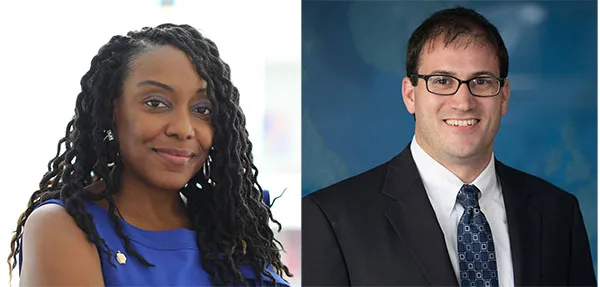
Turning Knowledge into Action to Generate Success
Through the Philadelphia Academy of School Leaders, educational leaders develop the skills and acumen to leverage the “knowledge in the room” to drive improved outcomes.
Leaders of Leaders supports those who supervise and develop principals to build principal capacity and increase student outcomes. Adept relationship management skills, coupled with strong systems and practices, serve as the foundation on which participants and their systems grow. Leaders build a strong community and collaborate with one another to share tools and resources, compare systems and practices, and discuss proven solutions—all elements that generate successes in student achievement.
As a third-year Assistant Superintendent overseeing a network of 12 schools, Jamina Clay (2016 Neubauer Fellow) keeps relationship-building at the forefront of her leadership practice. “Leaders of Leaders was helpful as a new administrator in trying to vision set and align the work I was doing with the needs of my schools, helping me look at my leaders and their needs and assess capacity,” said Clay.
In 2020, as educators everywhere navigated the challenges of the COVID-19 pandemic, Clay realized that her schools had a wealth of data, but it wasn’t shared in a way that would benefit the entire network. To address this, Clay cultivated an environment that encouraged principals to investigate the impact of a peer’s program through facilitated dialogue. She and her team restructured network meetings to create ample time to discuss evidence-based practices driving student results in individual schools. This well-received change to Clay’s network meetings–relationship building that leverages the knowledge in the room–resulted in greater collaboration across her network and increased communication among principals, creating more productive Professional Learning Communities (PLCs) focused on common planning.
“We still have strong communication between schools, and we still have a wealth of data,” said Clay. “We work together to understand the driving force behind the data. We worked to make sure students are engaged in the assessments so we have the information we need, digging into the data with intentionality and going beyond the percentages and averages into the actual numbers and what the percentages represent.”
Clay generates an environment in which principals dig beyond the surface level of data, and she works with her leaders to look at numbers from a systems level. “How do you maximize and capitalize on the skills and experience of the teachers whose numbers reflect success? How do we make changes that will impact the entire building?”
For Clay, it’s about analyzing the data and implementing proactive strategies to meet goals and expectations. “How are we looking at year over year data and making plans ahead of time to address the needs of the school?” said Clay. “We look at systems of accountability. What are the goals, and how are we looking at the work and ensuring that everyone is meeting the expectations?”
As she heads into the new academic year, Clay looks to ensure that the policies and practices align with equity. “We can have a big curriculum push, we can make sure our books have representation in them, but that doesn’t get us to the point of equity,” said Clay. “The work of how we implement the curriculum is equally important as the curriculum design.”
Ted Domers, 2015 Neubauer Fellow and a graduate of the 2020-21 Aspiring Assistant Superintendent Academy (AASA), was named a district Assistant Superintendent in 2021. Domers, who oversees 19 schools, also identifies School Leaders programming as helpful in connecting the dots between relationship building, shared knowledge, and results.
“Through my experience in AASA, it became clear that we are better when we work together,” said Domers. “Ultimately, building relationships gives us the opportunity to build capacity.”
For Domers, that manifested in scaling successes across his network. “Very early on, I spent time thinking about, how do I scale something, how do I build relationships when I’m spread across 19 schools?
“In School Leaders programming, there’s a strong focus on systems leadership and alignment, how to identify priorities and mobilize folks to make it happen,” said Domers. “Scaling impact is embedded in the program design–learning how to collaborate with my principals to collectively identify priorities, determine the menu of strategies we might implement in connection with practice, and align that with outcomes. Seeing those systems connecting, I became a much more focused leader with the principals I support. I need principals that feel connected to their strategies.”
His emphasis on building relationships to develop capacity quickly paid dividends. Prior to his first year as Assistant Superintendent, Domers explored different data points of success and learning. Identifying 30 potential areas of focus, he encouraged cross-collaboration and open conversation among his network principals to narrow the areas of focus and create new PLCs based on common interests and shared goals. Working together, principals shared resources, data, and findings and leveraged that knowledge to build capacity that emphasizes student achievement, equity, and social and emotional development.
Headed into his second year as Assistant Superintendent, Domers has a clearer vision for how he executes the work to improve student outcomes. He works to “align the outcome and goals with principal strategies and actions in a linear way, achieving alignment between strategies, practices, and outcomes.”
He references Leaders of Leaders’ use of the Model Principal Supervisor Professional Standards as a framework and resources around adaptive leadership as impactful in his own leadership practices.
“The Principal Supervisor Standards provided a common framework upon which to build, and the readings about adaptive leadership helped us think about how we see ourselves as leaders and what leadership attributes will help move the needle with others,” said Domers. “It was never the expectation that my colleagues would do things the exact same way. But we are all designing systems, thinking about who we are as leaders, and supporting our principals to move schools forward.”